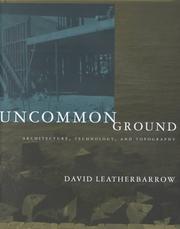| Listing 1 - 2 of 2 |
Sort by
|

ISBN: 113593116X 128010709X 0203997964 9780203997963 9780415949750 0415949750 9780415949767 0415949769 9786610107094 6610107092 0415949769 0415949750 9781135931117 9781135931155 9781135931162 1135931151 Year: 2005 Publisher: New York : Routledge,
Abstract | Keywords | Export | Availability | Bookmark
 Loading...
Loading...Choose an application
- Reference Manager
- EndNote
- RefWorks (Direct export to RefWorks)
This volume, through theoretical essays and empirically grounded pieces on Le Corbusier's designs, contemporary suburbs, and the planning agendas of the World Trade Center site, provides theory on the appreciation of site and context in architecture.
Building sites --- Architecture, Modern --- Architecture --- Site planning --- Planning. --- History --- Electronic books. --- Building sites - Planning. --- Architecture, Modern. --- Building sites. --- Chantiers de construction --- Aspect environnemental. --- Planification. --- Aspect environnemental --- Architecture, modern --- Planning --- 20th century --- 19th century

ISBN: 0262278049 1423725247 9780262278041 9780262338547 0262338548 9780262122306 9781423725244 0262122308 Year: 2000 Publisher: Cambridge, Mass. : MIT Press,
Abstract | Keywords | Export | Availability | Bookmark
 Loading...
Loading...Choose an application
- Reference Manager
- EndNote
- RefWorks (Direct export to RefWorks)
How building and site, technology and topography, interact to create successful buildings and resolve theoretical issues in practice.Although both are central to architecture, siting and construction are often treated as separate domains. In Uncommon Ground, David Leatherbarrow illuminates their relationship, focusing on the years between 1930 and 1960, when utopian ideas about the role of technology in building gave way to an awareness of its disruptive impact on cities and culture. He examines the work of three architects, Richard Neutra, Antonin Raymond, and Aris Konstantinidis, who practiced in the United States, Japan, and Greece respectively.Leatherbarrow rejects the assumption that buildings of the modern period, particularly those that used the latest technology, were designed without regard to their surroundings. Although the prefabricated elements used in the buildings were designed independent of siting considerations, architects used these elements to modulate the environment. Leatherbarrow shows how the role of walls, the traditional element of architectural definition and platform partition, became less significant than that of the platforms themselves, the floors, ceilings, and intermediate levels. He shows how frontality was replaced by the building's four-sided extension into its surroundings, resulting in frontal configurations previously characteristic of the back. Arguing that the boundary between inside and outside was radically redefined, Leatherbarrow challenges cherished notions about the autonomy of the architectural object and about regional coherence. Modern architectural topography, he suggests, is an interplay of buildings, landscapes, and cities, as well as the humans who use them. The conflict between technological progress and cultural continuity, Leatherbarrow claims, exists only in theory, not in the real world of architecture. He argues that the act of building is not a matter of restoring regional identity by re-creating familiar signs, but of incorporating construction into the process of topography's perpetual becoming.
Building sites --- Architecture and technology --- Architecture --- Art, Architecture & Applied Arts --- Planning --- Environmental aspects --- Architecture, Western (Western countries) --- Building design --- Buildings --- Construction --- Western architecture (Western countries) --- Technology and architecture --- Site planning --- Design and construction --- Art --- Building --- Technology --- Architecture and technology. --- Planning. --- Environmental aspects. --- Neutra, Richard Joseph, --- Raymond, Antonin, --- Kōnstantinidēs, Arēs, --- Criticism and interpretation. --- ARCHITECTURE/Architectural History/Modern Architecture --- Konstantinidis, Aris, --- Konsztantinidisz, Arisz, --- Κωνσταντινίδης, Αρης, --- Rajman, Antonin, --- Neutra, Richard, --- Neutra, Richard --- Neutra, Richard J. --- Building sites - Planning --- Architecture - Environmental aspects --- Neutra, Richard Joseph, - 1892-1970 - Criticism and interpretation --- Raymond, Antonin, - 1888- - Criticism and interpretation --- Konstantinides, Ares, - 1913- - Criticism and interpretation
| Listing 1 - 2 of 2 |
Sort by
|

 Search
Search Feedback
Feedback About UniCat
About UniCat  Help
Help News
News